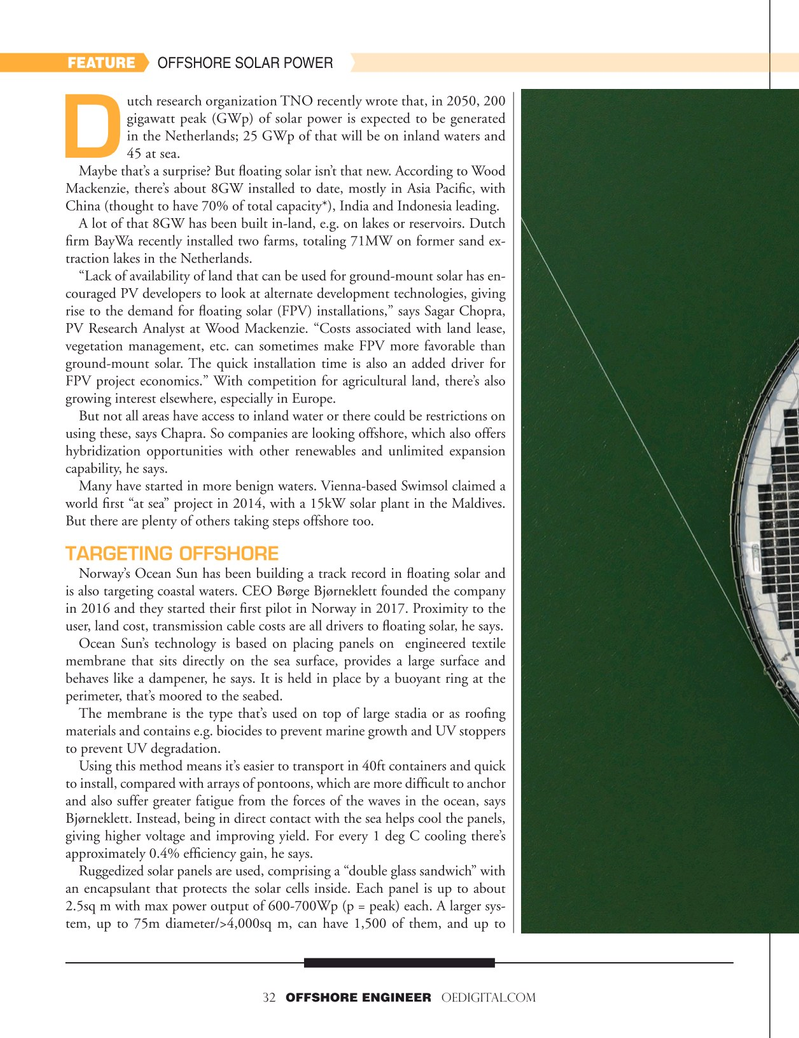
Page 32: of Offshore Engineer Magazine (Sep/Oct 2022)
Read this page in Pdf, Flash or Html5 edition of Sep/Oct 2022 Offshore Engineer Magazine
FEATURE OFFSHORE SOLAR POWER utch research organization TNO recently wrote that, in 2050, 200 gigawatt peak (GWp) of solar power is expected to be generated in the Netherlands; 25 GWp of that will be on inland waters and
D 45 at sea.
Maybe that’s a surprise? But foating solar isn’t that new. According to Wood
Mackenzie, there’s about 8GW installed to date, mostly in Asia Pacifc, with
China (thought to have 70% of total capacity*), India and Indonesia leading.
A lot of that 8GW has been built in-land, e.g. on lakes or reservoirs. Dutch frm BayWa recently installed two farms, totaling 71MW on former sand ex- traction lakes in the Netherlands.
“Lack of availability of land that can be used for ground-mount solar has en- couraged PV developers to look at alternate development technologies, giving rise to the demand for foating solar (FPV) installations,” says Sagar Chopra,
PV Research Analyst at Wood Mackenzie. “Costs associated with land lease, vegetation management, etc. can sometimes make FPV more favorable than ground-mount solar. The quick installation time is also an added driver for
FPV project economics.” With competition for agricultural land, there’s also growing interest elsewhere, especially in Europe.
But not all areas have access to inland water or there could be restrictions on using these, says Chapra. So companies are looking offshore, which also offers hybridization opportunities with other renewables and unlimited expansion capability, he says.
Many have started in more benign waters. Vienna-based Swimsol claimed a world frst “at sea” project in 2014, with a 15kW solar plant in the Maldives.
But there are plenty of others taking steps offshore too.
TARGETING OFFSHORE
Norway’s Ocean Sun has been building a track record in foating solar and is also targeting coastal waters. CEO Børge Bjørneklett founded the company in 2016 and they started their frst pilot in Norway in 2017. Proximity to the user, land cost, transmission cable costs are all drivers to foating solar, he says.
Ocean Sun’s technology is based on placing panels on engineered textile membrane that sits directly on the sea surface, provides a large surface and behaves like a dampener, he says. It is held in place by a buoyant ring at the perimeter, that’s moored to the seabed.
The membrane is the type that’s used on top of large stadia or as roofng materials and contains e.g. biocides to prevent marine growth and UV stoppers to prevent UV degradation.
Using this method means it’s easier to transport in 40ft containers and quick to install, compared with arrays of pontoons, which are more diffcult to anchor and also suffer greater fatigue from the forces of the waves in the ocean, says
Bjørneklett. Instead, being in direct contact with the sea helps cool the panels, giving higher voltage and improving yield. For every 1 deg C cooling there’s approximately 0.4% effciency gain, he says.
Ruggedized solar panels are used, comprising a “double glass sandwich” with an encapsulant that protects the solar cells inside. Each panel is up to about 2.5sq m with max power output of 600-700Wp (p = peak) each. A larger sys- tem, up to 75m diameter/>4,000sq m, can have 1,500 of them, and up to 32 OFFSHORE ENGINEER OEDIGITAL.COM

 31
31

 33
33